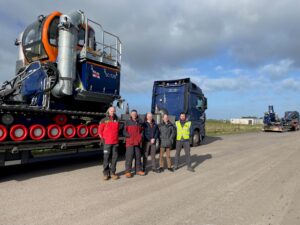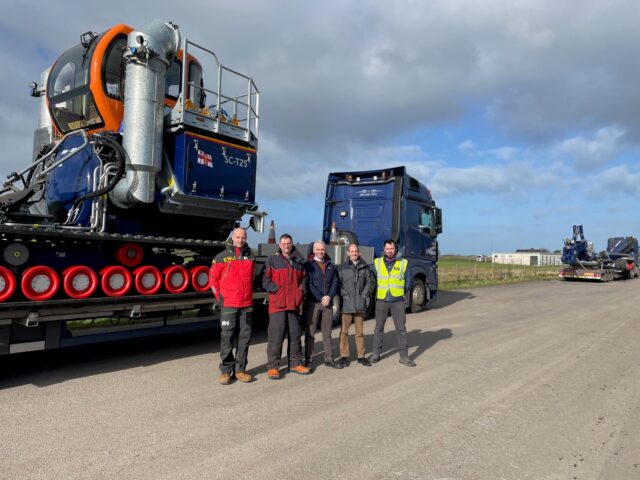Shannon Launch & Recovery System marks 20 years of collaboration with RNLI
22-02-2022Twenty Years of RNLI Collaboration marked by the completion of SC25 Shannon Launch and Recovery System
SC Innovation jointly developed the state-of- the- art system with the RNLI from early concept stage through to production and into service, and SC Innovation is continuing to support the SL&RS fleet under a new framework contract with the RNLI providing post design services and maintenance.
The SL&RS is a high-mobility tractor and tracked carriage system that acts as a mobile slipway to beach launch and recover the RNLI’s Shannon Class boat at lifeboat stations without a harbour or slipway. The 20.2m long and 37 tonne vehicle system is capable of carrying the 18 tonne Shannon over steep shingle banks, gullies and long muddy flats at speeds up to 10mph. It can operate in heavy surf conditions in depths approaching 3m and is fully submersible in depths up to 9m.
Joe Wilcox, Head of Projects, SC Innovation, said, “We are immensely proud of our collaboration with the RNLI in producing an exceptional piece of equipment that is making a difference in saving lives at sea. The challenge it presented has enhanced our engineering skillsets, especially for the marine environment, and it has become a showcase for our engineering capabilities in developing bespoke equipment for hostile environments and high mobility transportation”.
The journey started in 2002 when SC Innovation’s solution to the RNLI’s challenging requirement for a vehicle to beach launch a new All Weather Lifeboat – then designated FCB2 to replace the Mersey Class – became one of two selected for pre-prototype development. The vehicle had to match the RNLI’s evolving FCB2 design, which would be the first water jet propelled all weather lifeboat and need to be able to be both launched and recovered `Bow First’ with the minimum amount of involvement from the volunteer shore crew.
The RNLI conducted a two-year side by side trials programme with a view to selecting one or both solutions. The prototypes were tested at stations representing the extreme conditions where Shannon would be beach launched – steep shingle gradients at Dungeness, long distances over flat sand and gullies at Wells-Next-The-Sea and rough Atlantic swells at Hayle. The SC Innovation design’s superior mobility, utilising a permanent, software controlled Four-Track-Drive system for extreme traction, won it the sole pre-production development contract in 2008.
The pre-production design incorporated a series of upgrades, such as a new composite cab to increase driver situational awareness, a new cradle and boat interface to match the modified lifeboat hull, and a suite of minor changes to improve maintainability and supportability over the system’s projected 50 year life. A new 450hp Scania engine was also integrated to match what the RNLI were fitting to the lifeboat, again to reduce total system ownership costs for the RNLI.
In 2012 the first production standard SL&RS was unveiled and entered service at Dungeness in 2014 with SC Innovation building the next two to support the Shannon’s initial introduction into service. The second competitively tendered production contract was won by SC Innovation the following year. At the request of the RNLI, in 2016 SC Innovation designed a new two-track drive `non-powered carriage` variant to save costs for lifeboat stations with more benign conditions where less traction is needed.

From left to right:
- Luke Priddle: RNLI Technical Surveyor
- Steve Dyer: SC Innovation Works Manager
- Craig Walker: SC Innovation Senior Project Manager
- Simon Turner: SC Innovation Principal Engineer
- Jack Andrews: RNLI Senior Engineer, Launch and Recovery System
Share this article:




